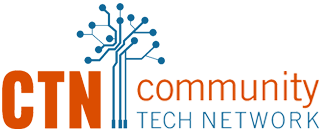“We feel CTN is a thought leader in the digital inclusion space. There are not a lot of organizations that do what CTN does, which is having a specific and explicit focus on technology and the digital divide.” — Jesse Rodriguez, interim program manager of the Community Technology Division of the City of Austin.
When the City of Austin first launched its website in the ’90s, it seemed like a natural development given the growing popularity of the internet. Yet soon after its launch, the City realized that the more services they make available online, the more they have to ensure that people can access those services. This meant that they would need to take extra steps to promote access and use of the internet — not only to access city services but also to participate in the city’s growing digital economy.
“Technology raises the ceiling of what is possible, but it also raises the floor of what you need to be able to participate,” reflects Jesse. “The City’s programming is designed to kind of make sure that we’re not leaving anyone behind by advancing technology, while also making sure that folks are able to still access it.”
A subset of the City’s Office of Telecommunications & Regulatory Affairs, the Community Technology Division aims to improve the community’s ability to participate in the digital society through a robust set of programs and initiatives. They currently partner with Austin Free-Net to provide digital literacy education services, computer lab support, and training services to other organizations. The City also operates a device refurbishment program that puts low-cost licenses on retired city devices, then distributes them to nonprofits and community members.
GTOPs Grants
Another major initiative of the Community Technology Division is its Grant for Opportunities in Technology (GTOPs) program. This program provides grants to Austin-based nonprofits involved in digital inclusion work. The goal is to increase the use of digital and communications technology, devices, the internet, and knowledge and skills related to technology.
Every year, GTOPs allocates $400,000 to its three grant pathways: the Core, Capacity, and Mini. The longest-standing pathway, GTOPs Core, awards up to $275,000 in funding per year, each award up to $35,000 to a single organization doing digital inclusion work. It is geared towards larger organizations working on a new program or intensive project. Next is the GTOPs Mini, a service delivery grant that awards up to $50,000 total per year. It is designed to support smaller organizations working on a shorter-term digital inclusion project, with awards between $5,000 to $10,000. Last is the GTOPs Capacity, a non-client-serving micro-grant with $25,000 total funding available per year. It awards $150 to $2,500 to help build capacity for nonprofits by funding technology infrastructure, staff training, and development opportunities.
Since its inception in 2002, GTOPs grants have funded an expansive set of initiatives and projects. These include workforce development programs, creative media training, computer labs, STEM programming, and technology training programs for people with disabilities. As Jesse puts it, “We don’t take a prescriptive view of what is a digital inclusion program. Technology is constantly changing and evolving, so new programs could come around every year.”
Over the years, CTN has received multiple Capacity grants from the City of Austin to support various digital inclusion efforts. Since 2020, CTN’s executive director, Kami Griffiths, has served as the facilitator for the Digital Empowerment Community of Austin (DECA) calls. These twice-a-month, hourlong calls gather Austin nonprofits and thought leaders to have in-depth conversations surrounding digital equity. The grant also supported Kami in leading the organizing committee for 2021’s Digital Inclusion Week (DIW). This included planning DIW activities and facilitating a webinar on how nonprofits have tackled the digital divide throughout the pandemic.
“CTN is a key partner for us to have these community conversations and find out what the needs are, where the gaps are, and how we can keep all of these other organizations who are on the periphery of the digital inclusion conversation engaged,” reflects Jesse.
In 2021, CTN also received a GTOPs Core grant to support Senior Connect. This collaborative program between CTN, AGE of Central Texas, and Senior Access will provide a 10-inch tablet, help signing up for the internet, and five hours of remote training to over 170 older adults in Central Texas. The City of Austin’s funding will help CTN connect 28 unique learners through the Senior Connect program.
“Kami has been a big focal point in the community as somebody that helps push conversations forward,” says Jesse. “She has a lot of history doing work on digital equity topics, both here and in California. We’ve funded a couple of grants to CTN that were successful in connecting seniors to technology and digital literacy training, which is a direct relationship between CTN and the City. But that is certainly not the only contribution that Kami and CTN have brought to the digital inclusion conversation in Austin.”
Next Steps
In the coming year, the Community Technology Division is creating a road map of next steps for the continued growth of its services. They are working on a range of data collection efforts, including mapping the digital divide, analyzing census information, conducting focus groups, and launching a quantitative study of the whole Central Texas region. This information will help the City refresh its digital inclusion strategic plan and better meet the community’s needs. For now, CTN is grateful to play a role in Austin’s digital inclusion movement. We’re grateful for the City of Austin’s continued support and look forward to collaborating with them as we work towards a more digitally inclusive Austin!


Comments are closed.